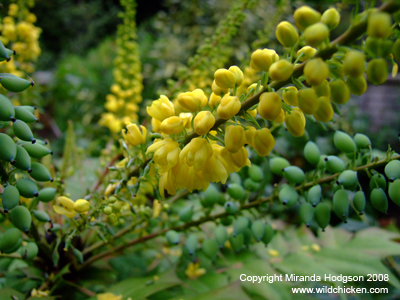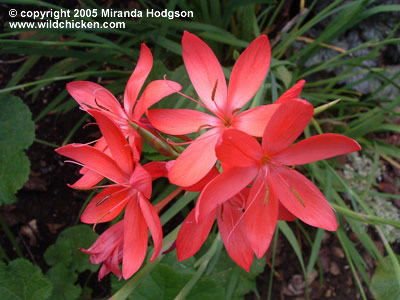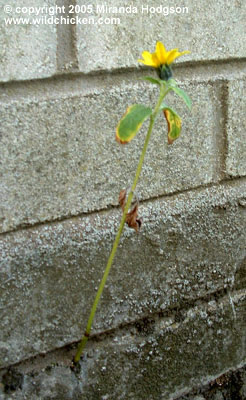November 15th 2005 - Autumn and winter colour
Whilst many of the Mahonia x media 'Charity' plants out there have slowed down or stopped by now, it’s reassuring to see the autumn and winter plants stepping up to take their place on the stage, ensuring colour for us humans and food for late foragers. There is Mahonia x media ‘Charity’ in full bloom, bright sprays of tiny yellow flowers giving off their faint sweet perfume. Buds have opened into flattened heads of pink blossom on two Viburnum tinus ‘Eve Price’, whilst V. farreri (similar to V. x bodnantense 'Dawn') is displaying racemes of pale pink, fragrant flowers.
"...bright sprays of tiny yellow flowers giving off their faint sweet perfume "

Mahonia x media ‘Charity’
A scrambling specimen of Jasminium nudiflorum has six-petalled yellow flowers opening along its arching stems and brightens the fence between us and next door. In a shady corner under the kitchen window, the flowers of Sarcococca confusa are getting ready to open, so we can look forward to their sweet perfume. As the plant only went in at the end of last year, the scent will no doubt surprise us for a moment or so when we open the window.
Under the apple tree, three little Cyclamen coum plants are just starting uncurl their stems from under the bark and are opening yet more pale pink blooms. The bird planted wild Primula vulgaris have been flowering intermittently all year, under shrubs and in corners, patches of yellow switching on and off quietly to themselves.
They’ll be joined by the snow drops in another couple of months and hopefully the Iris reticulata ‘Harmony’ will make another showing. They were so welcome last winter, the intense purple and yellow striking against the snow and such a pleasure to see when so many plants are sleeping.
At the edge of the patio, the mixed Cornus that I put in earlier this year are losing their leaves to reveal orange, green and red stems. They’ve grown a quite lot since being planted and I’m still hopeful that their increasing bulk and leaves will provide a bit of privacy within the next couple of years.
Still can’t stand the idea of putting fencing or trellising up instead, it would chop the garden in half and we wouldn’t be able to see the apple tree or watch the birds at the feeders which hang from it.
Still flowering since mid-summer is Verbena bonariensis; though a few of the stems have been bent by the recent high winds, their lilac heads are giving off a faint scent and attracting late butterflies. Schizostylis coccinea is another plant for rich autumn colour, its salmon pink petals brightening the bed next to the patio.
Surprisingly, the night-scented stocks (Matthiola bicornis) are still going. I thought they were more tender, and we’ve had a couple of good hard frosts already. They must be benefiting from the shelter of the Lavender that’s growing near them.

Schizostylis coccinea
While there are still some berries left on the Pyracantha and Cotoneaster plants, the birds are gradually working their way through them. The red ones go first, followed by orange and then yellow, so all the red-berried plants that were ablaze with colour a few weeks ago have now been stripped bare. It’s the blackbirds that take them.
I watch them out of the window in the early morning, as they flap and stumble through the branches to reach the fruit. I’m glad they’re leaving the orange Pyracantha for the moment, because the berries catch the golden light of dawn and turn to neon for a short time.
"...the little coal tits are busy planting seeds in inappropriate places..."
As the blackbirds are breakfasting, the little coal tits are busy planting seeds in inappropriate places, pushing the seeds of Eryngium giganteum ‘Silver Ghost' (which will grow to a meter in height) into the very edge of the lawn and stuffing sunflower seeds into holes in the garden wall.
How on earth sunflowers ended up growing there was a puzzle to us for some time, until we discovered it was done by a bird. After that, we kept an eye out and discovered that coal tits spend a good part of their day occupied with planting seeds. You have to wonder if they ever remember where they’ve put them. Judging by the number of plants that pop up in odd places, I’d say it doesn’t happen that often.

Bird-planted sunflower in the garden wall
Planting for year round colour and flowers can be complicated. There is more to think about than simply when a plant flowers. You also need to take into account what the foliage is like, whether it changes colour, and what the plant does for the non-flowering part of the year. It’s a bit like writing a complicated play, where you need to consider every cast member - who supports whom, how and when. What a lovely headache it gives you if you try to figure it all out at once, especially if there are already established plants in place.
Even though I feel I’ve only made a start on the project, it’s still really satisfying to see flowers suddenly appearing when so many other plants are in the process of going dormant for the next four months. If we had more space I’d like Chimonanthus praecox and some of the scented varieties of Hamamelis mollis and Lonicera x purpusii. As it is, we don’t have the space so I’ll just have to start collecting bulbs instead.
© Copyright Miranda Hodgson 2005